Panipat (Haryana): Seven men in red langotis stride into the courtyard of the Ram Mandir in Panipat. Sevaks tie ghungroos to their feet, smear their bodies with orange sindoor, affix a bamboo ‘tail’ to their backs, and bind their torsos with thick white cloth. Finally, they heft the 15-20 kg orange Hanuman mukuts— massive, grinning monkey faces—onto their heads. And just like that, they are the Hanumans of Panipat.
The belief is that these ordinary men are now transformed into gods. Their posture becomes more commanding, shifting from humility to dominance in the blink of an eye. They proudly rub their bellies as devotees scramble to touch their feet. The ‘gods’ oblige, patting their backs and pressing tilak on devotees’ foreheads. It’s the moment everyone has been waiting for. Chants of Jai Shree Ram and the Hanuman Chalisa reach a crescendo in the courtyard.
For the priests, participants, and supplicants, this is no dress-up parade. Every Dussehra, the Hanuman Swaroop phenomenon sweeps across Panipat, turning ordinary men into symbols of devotion and defiance. Most are from Panipat’s Punjabi community, with the tradition starting as a post-Partition expression of identity. But though the community is no longer ‘displaced’, over the last few years, the number of men and boys signing up has risen. The ranks of the Hanuman Sena have swollen to hundreds, if not more. It’s become a rite of passage.
In Panipat, Dussehra is less about Ram vanquishing Ravana and more about the heroism of Hanuman.
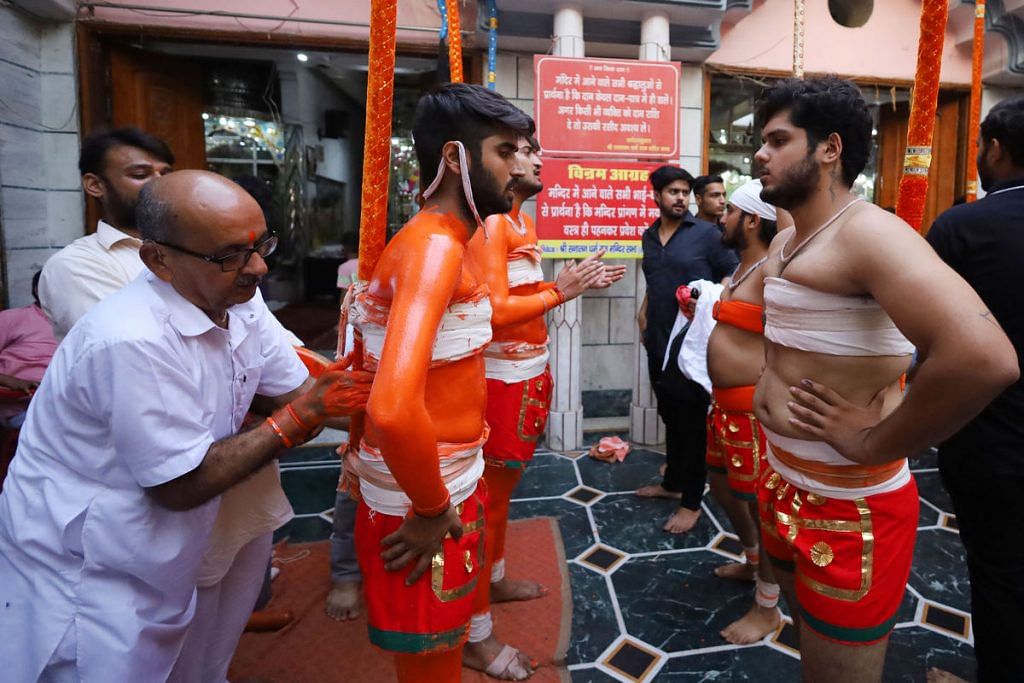
“We are Punjabis from Pakistan,” said 65-year-old Ganpat Khurana, who is donning the Hanuman Swaroop for the eighth time. “This tradition germinated during the British rule when the Englishmen didn’t allow us to celebrate Dussehra. Our saints back then took it up as a challenge. They applied vermillion on their bodies like Hanuman showing his love of Ram and protested.”
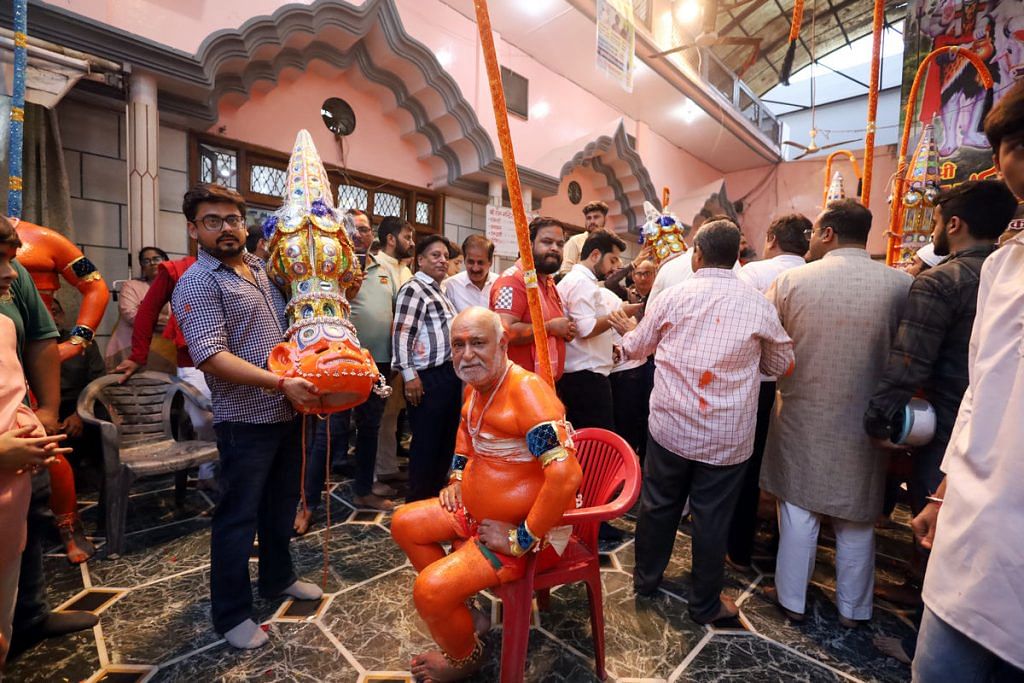
For nine days leading up to Duhssehra, the streets of Panipat are overrun with Hanumans, walking barefoot on the streets. It’s a carnival-like atmosphere—men and boys strutting about in their massive mukuts, dancing and chanting, “Ram, Ram”.
There’s an aspirant in every neighbourhood, but the path to this big moment is not easy. It’s a gruelling tapasya filled with prayers, rituals, and fasting.
“You don’t become Hanuman just like that. How do you think we get this shakti?” said Khurana.
“We avoid women, and even thinking about them,” said one young Hanuman with utmost seriousness, as others agreed.
Also Read: Haryana is the hotbed of gau raksha influencers and crimes of religious passion
Preparing to be Hanuman
The path to becoming a god—even if only for a day—starts 41 days before Dussehra. Men leave their wives, parents, and children behind to live in temples. There, they pray, perform rituals, and eat just one meal a day—without salt.
Ahead of the festival, Hanuman sabhas—typically rented rooms or temple courtyards—are set up throughout the city. Younger aspirants, including school-going boys, usually spend 21 days away from home. They abandon their roles as sons, brothers, and husbands to adopt the life of a brahmachari.
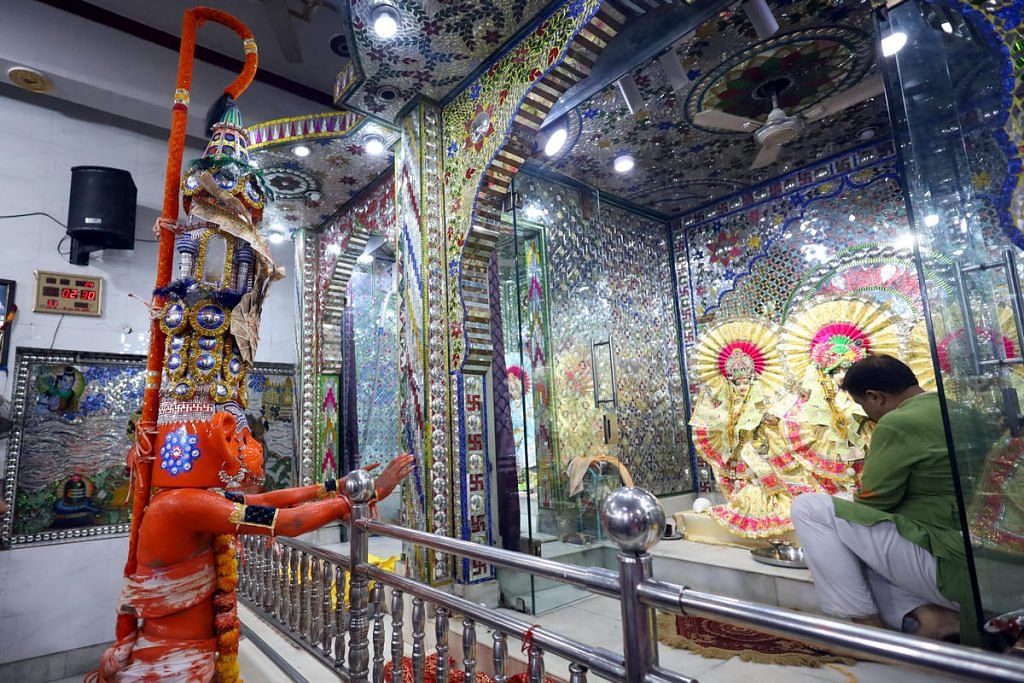
“We avoid women, and even thinking about them,” said one young Hanuman with utmost seriousness, as others agreed.
The list of dos and don’ts is endless. Besides the single saltless meal, they must bathe every time they use the washroom. They can’t use mobile phones or visit their families. They have to pray at least four times a day.
We’re Brahmins right now. You can’t use any swear words or slang against us—if you do, be prepared for god’s wrath
-Aayushman Chugh, 14
Once the decision is made, the boys and men live in temple rooms, or rent apartments together. Sevaks—usually friends— assist them with their daily rituals and preparations. The costumes can be specially ordered or procured from temples. The whole process can cost around Rs 10,000, if not more.
At 6.30 on Sunday evening, a procession set off from a Ram Mandir. The pounding of dhol baaja filled the streets as the men walked with their hands on their waists, mimicking Hanuman’s posture. When they arrived at a local banquet hall, they burst into dance, moving to the tune of “Jo Ram ko laaye hai hum unko laayenge” — a Bharatiya Janata Party campaign song.
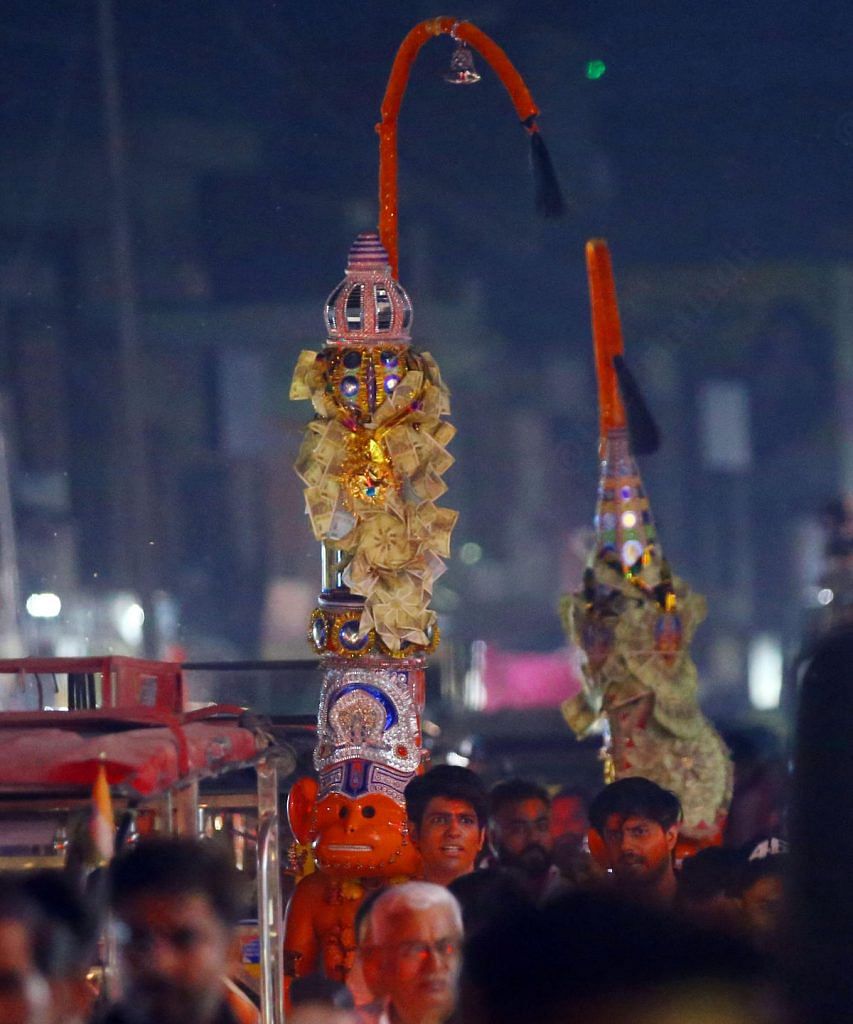
Mothers rushed to these newly formed gods, thrusting their children into their arms for a blessing.
After Dussehra, the men and boys will return home to pick up the pieces of their mortal lives.
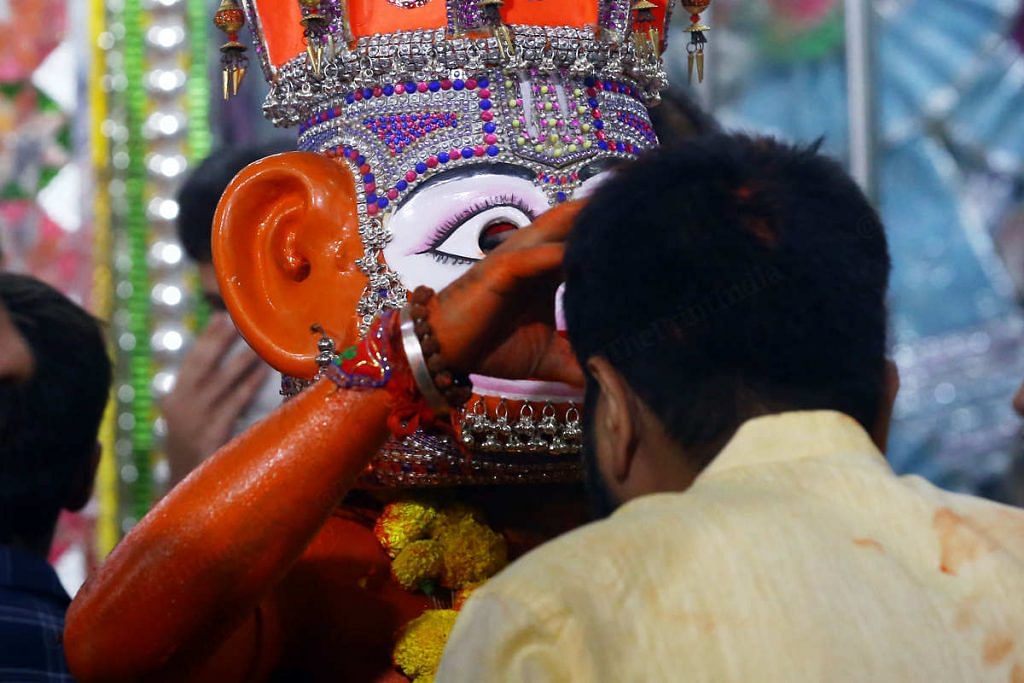
All the Panipat Hanumans have shed their own names for now. They are called ‘Maharaj’ and are served by six sevaks.
Temporary ‘Brahmins’
For 14-year-old Aayushman Chugh, becoming Hanuman is a dream come true. When he was just three years old, a relative asked him what he wanted to become when he grew up. Without hesitation, he replied that he wanted to be a Hanuman, just like his father and grandfather. It’s a family tradition.
This Dussehra will be the first time Chugh gets to follow in his father’s footsteps. Right now, he’s less worried about his future career than about how many more times he will become Hanuman.
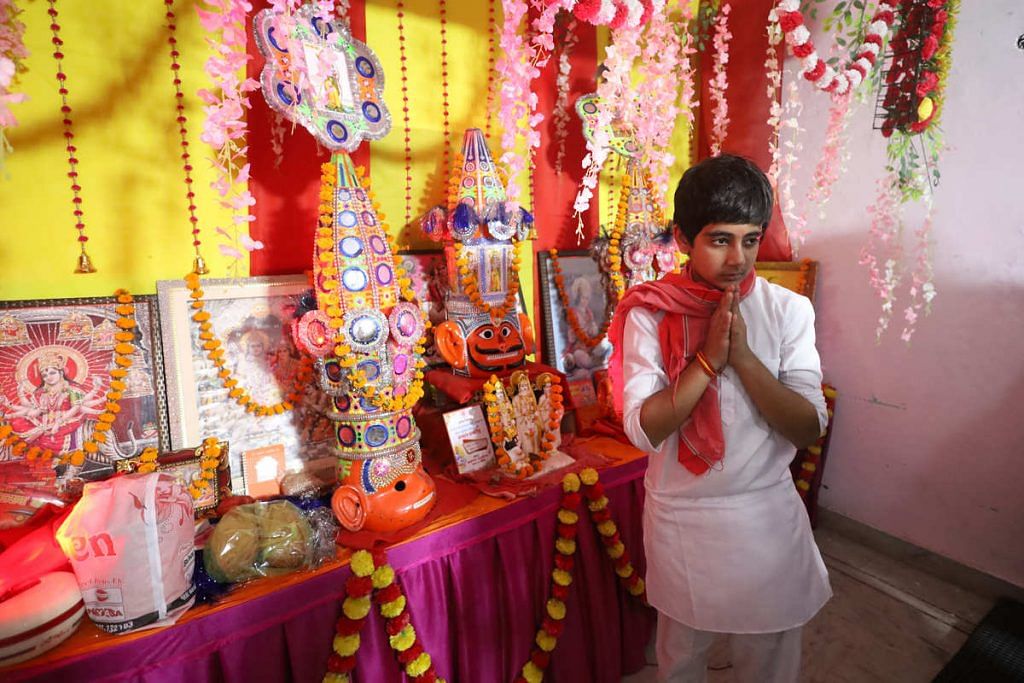
“I want to keep becoming Hanuman,” he said, though he admits he’ll likely take over his father’s business one day. Like several other men and boys participating in this tradition, his family has a thriving handloom business in Panipat.
The teenager’s even got the blessing of his parents to skip school. With all the rules—no shoes, no being in the vicinity of girls, no seating other than the floor—it’s impossible to attend classes, he explained.
Chugh, along with five other teenage boys, is staying in a rented apartment on the ground floor of a makeshift temple. Clad in white kurtas, with red scarves tied around their heads, they bond over stories of Hanuman’s life and teachings.
You don’t become Hanuman just like that. How do you think we get this shakti?
-Ganpat Khurana, 65
“Once, Hanuman asked Sita why she always wore sindoor. Sita said she did it for Ram’s long life. So, that day, Hanuman smeared sindoor all over his body,” Chugh recounted, as the boys listened intently.
“Waah Maharaj! Jai Shree Ram,” they responded in unison.
During this period, they’ve shed their own names. All the Panipat Hanumans are called ‘Maharaj’ and are served by six sevaks. The makeshift temple houses seven gigantic mukuts—one for each boy. They offer prayers and make daily offerings to these sacred headpieces. At night, they sleep on the floor, close to the mukuts. The boys do all of this without adult supervision, with only their fathers visiting them occasionally.
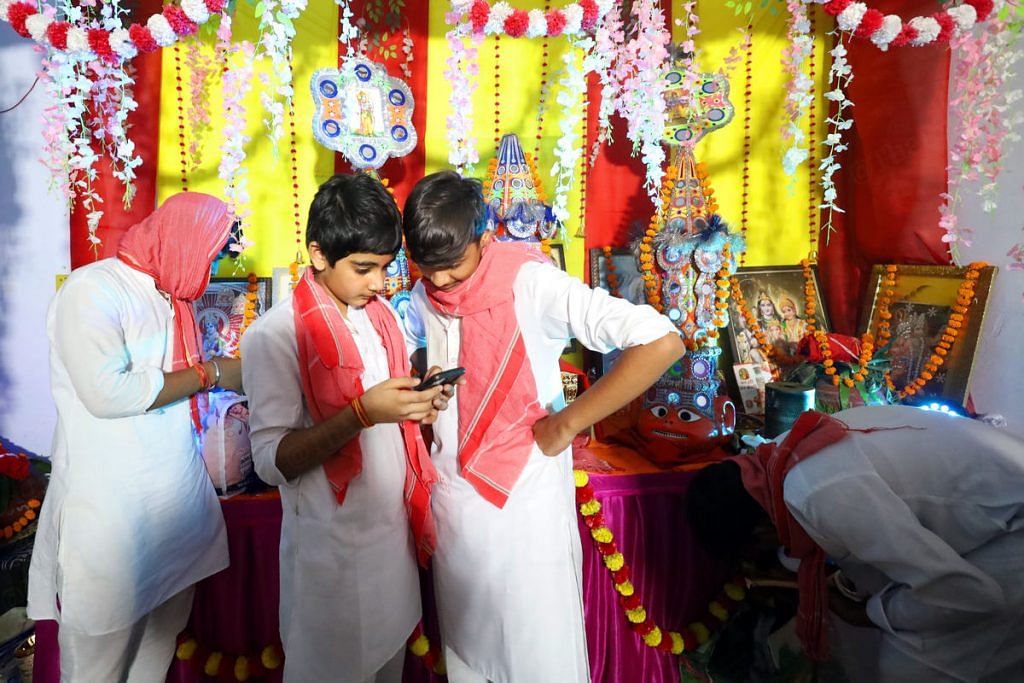
Chugh and his friends all belong to different castes, but insist that for this period, they are Brahmins.
When one of the boys let slip a swear word, the others immediately touched their earlobes and begged for divine mercy.
“We’re Brahmins right now,” Chugh declared, proudly showing off his janeu—the white thread worn by Brahmins. “You can’t use any swear words or slang against us—if you do, be prepared for god’s wrath.”
While this isn’t the only prevailing view about Hanuman’s ‘caste’, the Panipat community believes the monkey god to be a Brahmin. As a result, the Panipat Hanumans assume the markers of this caste during the festival.
Despite the strict rules, though, some rebellion does creep in among the new Haumans. They aren’t allowed to use phones, but Chugh uses his to record the bhog and upload it to his Instagram page, named “Ram Sevak Hanuman Sabha”. He also discreetly responds to a friend’s text.
At 2 pm, it’s time to offer bhog–food for the gods. There’s palak paneer, beetroot, cucumber, desi ghee, and dal — all devoid of salt and spices.
Sacrifice and pride
At a Ram temple a kilometre away, eight men in their 30s and 40s are observing strict fasts as they prepare to become Hanumans. Downstairs, the temple’s is full of activity—Ramayana plays, readings, and performances. But as one of the men points out, the Hanumans in the plays are just actors.
The eight “real” Hanumans are upstairs, following a strict schedule to honour their new role. At 2 pm, it’s time to offer bhog–food for the gods. There’s palak paneer, beetroot, cucumber, desi ghee, and dal — all devoid of salt and spices. The food has come from their respective homes, cooked by their mothers and not their wives, as Hanuman was celibate.
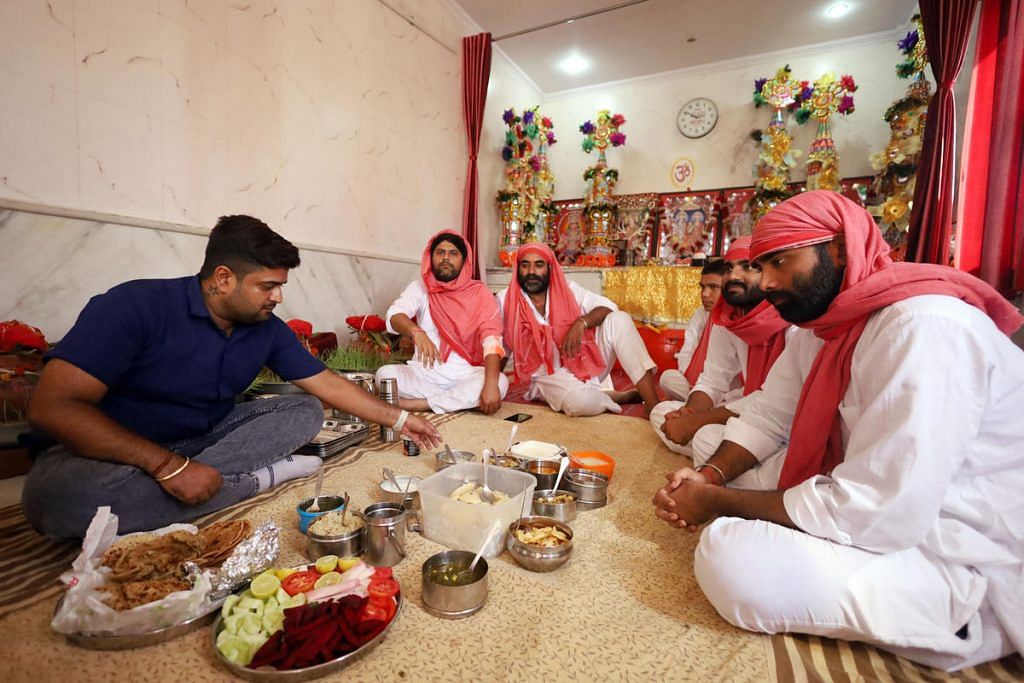
During the bhog, the men sit on the ground and sing prayers. The men say that Hanuman doesn’t eat food in front of everyone, so they draw curtains around the idols. After the food is offered to the gods, they sit down to have their only meal for the day.
Among them is 40-year-old Dinesh Chugh, who has taken leave from his job as a sales executive at a handloom company to go through this rite of passage for the first time.
“My office gave me time off after I told them about my wish to embody Hanuman,” he said. Hanuman Swaroop is part of the fabric of Panipat’s society— it’s a badge of honour for both the men and their families.
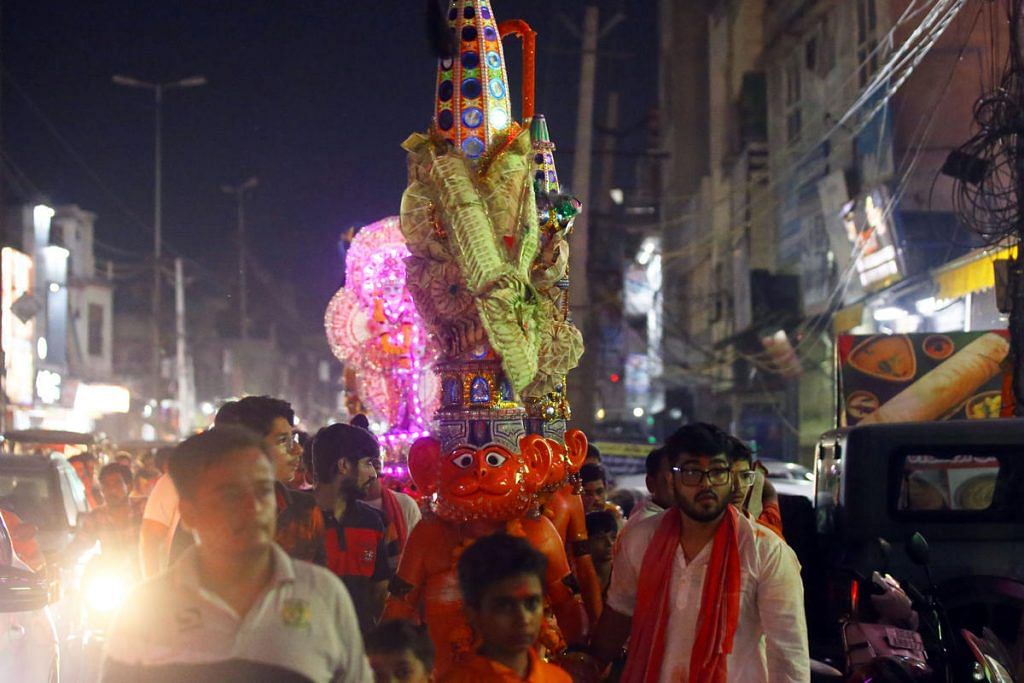
Then there’s 22-year-old Snehil Juneja, who fought with his parents for a week before they agreed to let him leave the house for 41 days and become Hanuman for the seventh time.
“Last year, he came down with dengue,” his mother Bharti said. “He didn’t eat salt for 41 days and it was hard for him to recover.”
But Juneja didn’t want to be left out, especially since all his friends are taking part again. Despite her initial reluctance, Bharti is proud of her son’s devotion. She often visits the Ram temple in Ward No 7 to catch a glimpse of him. And all the male relatives come by to touch his feet and present him with a paison-ki-maala (garland of money).
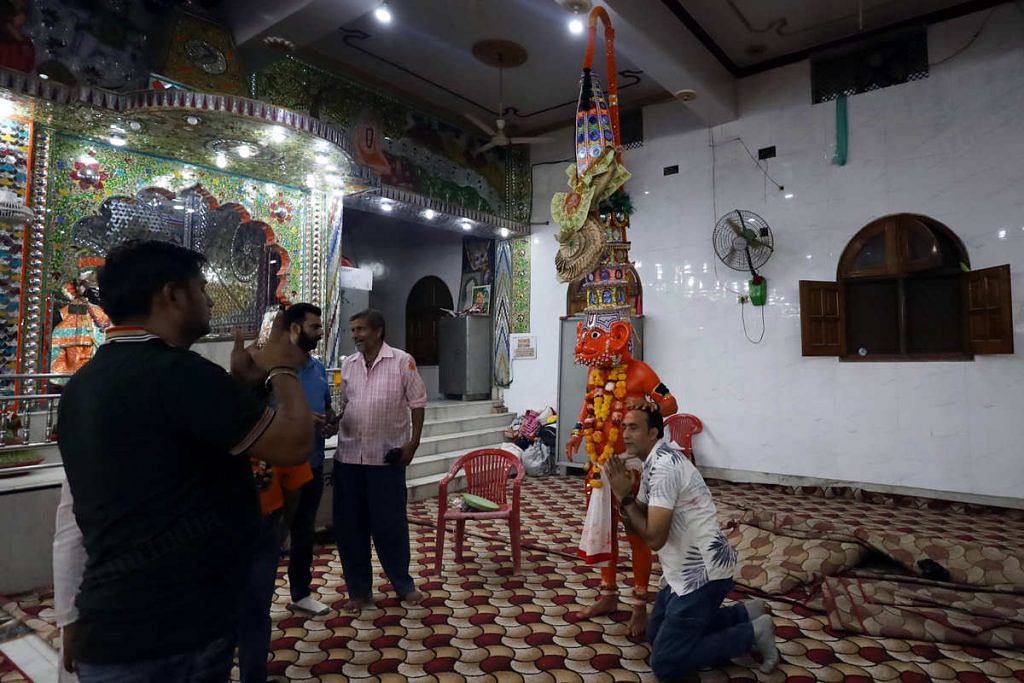
Man to Hanuman
At the temple where Juneja is cloistered, preparations for the Ram ki Baarat are in full swing. Around a dozen men in langots, their bodies smeared with vermilion and bamboo tails fastened to their backs, mill about, getting ready for the procession, which takes place on different dates depending on the temple.
Each man wears a unique mukut on his head. Some feature images of Ram and Sita, others bear an image of Hanuman with his chest torn open to reveal his heart, and some sculptural creations even have images of other deities, such as Durga.
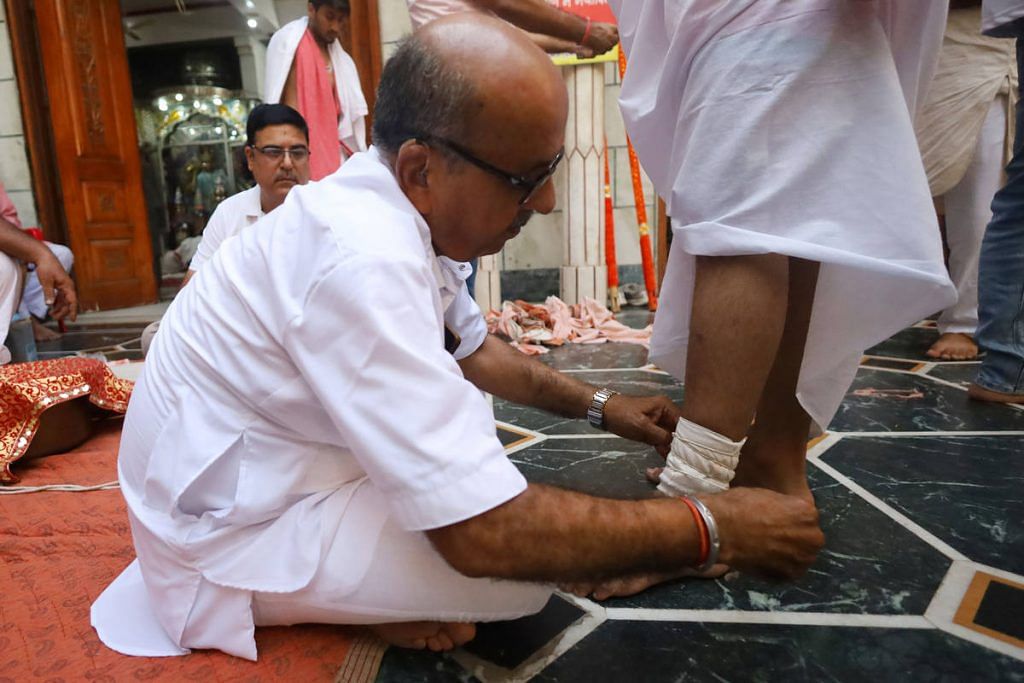
Though the temples usually offer mukuts to the Hanumans, it’s common for families to commission custom ones, with permission from the priests. Juneja’s mukut, which cost him Rs 15,000, has a small statue of Hanuman revealing his heart.
No matter the decorations, what all the mukuts have in common is their huge size, heaviness, and the fact that they are suffocating to wear, although for the men it’s a small price to pay.

A sevak nearby mixes sesame oil with vermilion in a huge metal bowl. The oil makes the vermilion stick to the body, he said. Once the men’s bodies are fully covered in this mixture, turning bright orange, they chant “Jai Shree Ram” a hundred times, keeping careful count.
“Jai Shree Ram ek… Jai Shree Ram do…” they chant in unison.

At 65, Ganpat Khurana is the oldest Hanuman in the group. He sits calmly on a chair as two younger men tie ghungroos to his feet.
Khurana first became Hanuman in 1995, driven by a personal wish.
“I had two daughters, but I wanted a son. Everyone advised me to take on this challenging task of becoming Hanuman. After that Dussehra, my wife gave birth to a boy,” he said. Today, that son, now 24 years old, is helping him get ready for the procession.
The same desire—for a son—is driving 32-year-old Gaurav Taneja, who is becoming Hanuman for the first time this year. As he gets ready, his three-year-old daughter watches from the temple entrance, crying, “Papa! Papa!”
People urge her to be quiet, as Taneja is in the process of transforming into a god, but her cries pull at him and he walks over to gently touch her head.
Suddenly, men surround him, shouting.
“How can you touch a girl?” they demand. “You are not her father right now but Hanuman—a brahmachari.”
Taneja steps aside as his daughter looks up at him.
“This is the culture. I am a god right now,” said Taneja, before walking away.
(Edited by Asavari Singh)



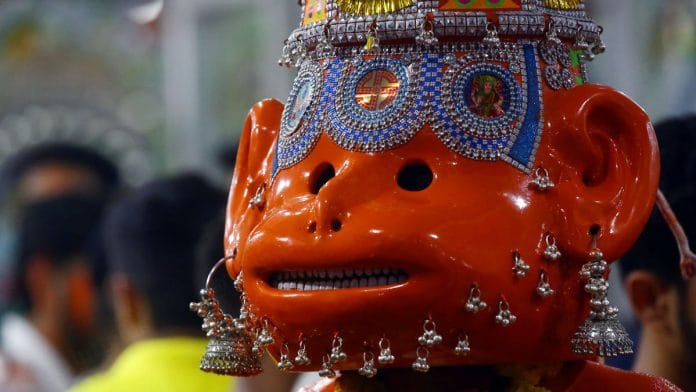



The last paragraph seems to have been inserted with the sole intention of portraying these devotees as misogynists. Without this paragraph, Ms. Kissu’s credentials as a journalist would have been questioned by the Left-liberal cabal. Just to satisfy the cabal and win it’s stamp of approval, a Hindu devotee, undergoing a really tough ordeal to prove his devotion, has been caricatured as a misogynist.
Punjabi Khatris from west panjab not Pakistan lol. All sikhs Guru’s are khatris too. Khatris don’t believe in Varna. We are kshatriya, Priests, Warriors and also Great Bussinessman. 2 Paramvir Chakras Vikram Batra, Arun khetrpal, 14 Military Chiefs 5-6 in Army ,4 Navy, 4 Airforce etc
Quality of Journalists and there writing has really gone down.
Repetitions, narratives, expressions, Vocabulary, punches are all missing
This could have been expressed a lot better
I am from Panipat. Dusshera alongwith numerous hanumans are awesome. Evening environment is so vibrant in city these days. I have been watching this from my childhood but now I moved to Gurgaon so I miss these days.
Ramayana is deeply embedded in Indian society, culture and psyche. It’s not just an epic or the object of scholarly debates but a part of our daily lives.
One cannot think of any other epic or work of poetry which has had so profound an influence over a civilization.